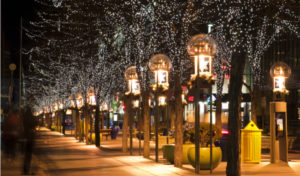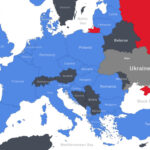At The American Conservative, Matthias Leyrer explains why the Christmas season, still rooted in tradition, needs strong downtowns. He writes:
The Christmas season is once again upon us. For many, “it’s the most wonderful time of the year.” But as our culture continues to squeeze the most out of the holiday, many of us have seen it become a relentless rat race. Presents need to be bought, pageants need to be held, dinners must be cooked, and cards have to be sent.
The saving grace of this onslaught of tasks is that Christmas music is back on the radio, in stores, and pretty much anywhere that has a PA system. Many of these songs were written during the immediate postwar period of optimism, cultural unity, and thriving Main Street economics. It’s Beginning to Look a Lot Like Christmas mentions all the classic signs of the holiday—the carols, the bells, the snow—but the first thing it portrays is “the five and ten (variety store) glistening once again with candy canes and silver lanes aglow.”
It’s clear that the role of these local shops and their front window displays goes far beyond shopping. They not only provide all the toys needed for presents and gifts (the entire third verse of the song) but are an essential part—if not the most central aspect—of the holiday ambiance.
Today, however, we’ve lost this unique part of the season. Whether it’s the constant sale of toys at our big retailers, or the year-round availability of holiday products through the internet, there is nothing actually special about shopping at Christmas. And it’s not just the experience we’ve lost—there is now less joy in the products that we buy.
The traditional cities that are sung about in our Christmas music don’t just highlight the spirit of the holiday, they create it. They make us take things slower. They get us walking amidst the lights and decorations on the buildings. They put us on the street, interacting with the other people enjoying the Christmas atmosphere. They are part of the season itself—free and welcoming to all.
For so many families around the country, Christmas is still rooted in tradition. Whether it be meals, songs, events, or the simple act of being together, it is a time where we turn our eyes to our family and acquaintances. Many people work hard to instill their Christmas traditions in their children. Why not ask the same thing of our cities? Do we want our children to associate Christmas with spending hours at the mall or lazily clicking through Amazon? Or do we want them to realize that our physical structures can be part of their heritage and have a lasting impact for generations?
Some conservatives will dismiss these reactions to the contemporary retail landscape as mere nostalgia:
Our poorly constructed cities are encouraged to overconsume, while the lack of quality public space has eroded our sense of community. The charm of Christmas now only lives in black-and-white movies, where it harkens back to a time and place that people have forgotten how to build. We’ve lost the “Main Street” that made it possible to frame public celebrations and holidays. Is Christmas now limited to plastic trees and lights in the front yard that we put up haphazardly because it’s the social norm?
As you run your errands this holiday season, pay attention to your surroundings. Ask yourself if these built environments are really emblematic of the “greatest nation on earth” or if they serve the purpose of interests—Wall Street and global corporations—not in line with your own best interests and those of your community.
Read more here.
If you’re willing to fight for Main Street America, click here to sign up for my free weekly email.






